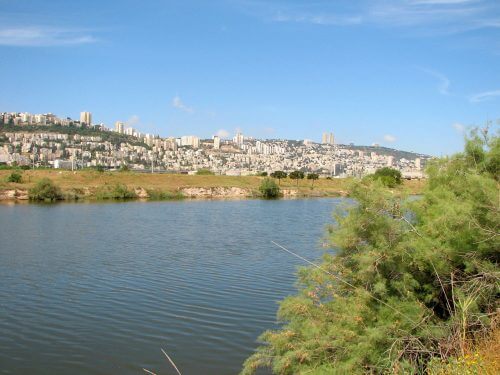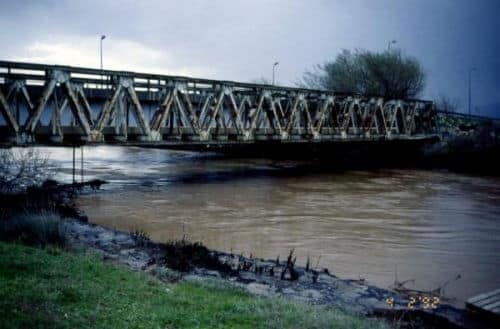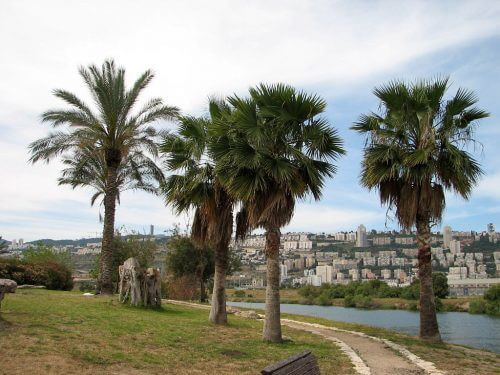The restoration works of the Kishon river and the construction of a green park along it are in the last line. But alongside the good news, claims are heard that contaminated soil remained in the stream

By Assaf Ben Naria, Angle, Science and Environment News Agency
78 years of pollution in the Kishon River, in the area where the heaviest industries in Israel are located, have left a heavy mark on the bottom of the river since the refineries started operating in the area. Fuels, oils and heavy metals that have sunk to the bottom over the years have accumulated into a thick and viscous layer whose black color illustrates more than anything the abnormal degree of pollution. The dimensions and severity of the contamination led to a delay of years in the implementation of the restoration project and the excavation of the contaminated soil, which the decision to carry out was already made in 2001 by the Israeli government.
The excavation work was completed almost a year ago, and with the restoration of the river, which for years was one of the most serious environmental hazards in Israel, the area is expected to become a thriving regional park for the residents of the north, similar to the transformation that the Hirayeh garbage mountain underwent in the center of the country, but there are those who think that the celebration is too early and that the restoration project has not yet has reached its true end point. Surprisingly, the main goal that was at the heart of the Kishon River restoration project was not related to the substances polluting the water, but rather to the prevention of flood damage. Behind the plan was the recognition that only the widening and deepening of the river channel in its western area would allow flood prevention. The expansion of the channel allows a larger amount of water to drain into the sea and thereby reduce the load on the existing drainage systems. The heavy rains of the winter of 1991 and the extensive flooding that followed were the ones that accelerated the promotion of the river restoration program, which is managed by the Kishon Drainage Authority.
It took nearly twenty more years for the river restoration project to come to fruition, and about four more years to announce its end. So after all the work and digging, what is the condition of the Kishon today? Can it be said that the river, which was once synonymous with pollution and environmental hazards, is now a symbol of the success of correcting the mistakes of the past? And how do the Ministry of Environmental Protection respond to claims that the process of clearing the soil was stopped without all the contaminated soil being removed from the river bed?
Excavations and excavations
B-2013 The dragger boat brought to Israel by the Canadian company Englobe, the winner of the Kishon bottom cleaning center, lifted anchor. The dredger, an amphibious hybrid of a D9 and a supertanker, is able to dig the bottom of the stream while moving slowly, while moving the contaminated bottom to land using a dedicated pumping system built for the project. The challenging restoration process lasted nearly two years, during which the bottom was also removed from a number of contaminated ponds, which were previously established along the bank of the river during an attempt to remove some of those contaminated sediments. Over the years, those pools have also become a source of significant pollution.
The ship's arrival was made possible after2011 the government decided On an action plan to clean the Kishon river from pollution. The emphasis was placed on the bottom of the stream and not on the waters of the stream, after a series of measures taken in the years preceding the decision, the main of which is the obligation of the factories to treat their wastewater before discharging it into the stream, resulted in a considerable improvement in the quality of the water.
The project was allocated about220 One million shekels, an amount that was half financed by the polluting enterprises, according to the "polluter pays" principle, and half by the public through funds transferred by the various government ministries and local authorities.
The main goal of the project was to deepen the channel of the Kishon River, at the bottom of which, over the years, viscous and extremely polluted sediments, originating from the effluents of the factories that operated in the bay, had accumulated over the years. In addition to the fatal damage of the contaminated sediment to the water quality and biology in the stream, it also interfered with the flow of water in the stream. In the case of heavy rains in the catchment basin of the river, which drains a huge area of approx.1,100 square kilometers, severe flooding was caused in the Haifa Bay area. The deepening of the river channel was supposed to allow better regulation of high water flows and later perhaps also the navigation of boats in the water.

One of the significant moves carried out as part of the restoration project is the addition of a "naphthol", a kind of detour that leaves the stream and connects back to it. The idea behind the Naftul is that digging a new and winding route to the stream in the factory area will help break the linear route that characterized the stream and allow habitats to exist along the new banks.
In the end, it was decided to keep both the original route and the new path, and thus a new island was created between them, which is planned to later become the center of the regional park that will stretch along the stream. From an environmental point of view, it was decided that a significant part of the island's soil would come from the bottom of the Kishon, from those polluted meters that are soaked in pollutants, and for this purpose a set-up for treating the contaminated soil was established on the spot. Indeed, water squeezed from the tire soil also went through a restoration process and was eventually released back into the stream.
Significant gaps between the plan and the execution
according to Evaluations Prior to the execution of the project, the volume of the contaminated soil to be cleared was estimated at 400-340 thousand cubic meters (cubic). Tests conducted on the spot revealed that the thickness of the contaminated layer reached up to 2.5 meters in some areas of the river. In practice, 150 cubic meters were excavated from the bottom of the stream and about 90 additional cubic meters from the ponds along the banks - about 240 cubic meters in total.
How did the gap between the plan and the implementation in the field arise? While the restoration plan referred to the last seven kilometers of the stream, in practice only the last five were excavated. In addition, the depth of the excavation that was decided on in the two additional kilometers up the stream was about 20 centimeters, but during the works It was decided not to carry out the excavation in this route. The reasons for this were that the pollutant concentrations in this layer are low and that in terms of drainage, deepening the stream will not have a significant effect. Engineering difficulties also led to the fact that contaminated soil under several bridges was not excavated, as well as near the banks of the stream, the depth of which did not allow the work of the marine excavator.
During the period of the works, serious financial disputes were discovered between the Canadian company, which was chosen in an international center to carry out the project, and the project administration. These disputes led to the shutdown of the works and eventually to the replacement of the performing company.
"The environmental treatment has not been completed"
The "Clear" organization, which for years pushed for the restoration of the river, is the one that is currently leading the fight against the authorities who have already rushed to announce the end of the project. as per clear, the treatment of the river bottom was not completed and whole sections of the river bed were not treated and remained polluted. Also from a drainage point of view, according to them, in whole sections, the stream section was not deepened, so the main purpose of the project - preventing flooding - was not achieved. In terms of clearing the soil, compared to the quantities estimated by the project planners to be cleared, "less than 50 percent of the toxic sludge has been removed from the stream", says "Clear".
According to Dr. Yuval Arbel, the coordinator of the marine sector at Tzulul, in the documents that defined the goals of the project it was written "black on top of white" that the bottom should be removed until the drainage flow section is reached (that is, the depth that existed before the drift and factory effluents sank on top of the bottom) and also remove all the toxic sludge. "But the bottom line is, not all the mud was removed," he says.

Despite the sludge problem, one of the problems that bothers Arbel the most is the lack of transparency in terms of the body responsible for managing the project. "We submitted a request for information ten months ago, and we have not yet received a response," he complains. According to him, there is no information available and there is no orderly report showing the works that were done and those that were not done, and "such a situation cannot be accepted".
"Everything that was supposed to come out - came out"
"The statement that the entire quantity did not come out is not relevant at all," says Alon Zasek, Senior Vice President of the Natural Resources Cluster of the Ministry of Environmental Protection. Zasek, who served until 2015 as head of the Water and Streams Division, explains that the tender stipulated that the excavation should be done up to the hydraulic and ecological cut. That is, when the restoration work is finished, the stream will be able to drain successfully, but also that the conditions in it will allow the existence of life in the stream.
"The most significant extent of contamination is in the upper two meters of the bottom of the river," emphasizes Zasek, "in practice we deepened up to 2.5 meters to have a margin of safety." But does this mean that all the polluted sludge has been removed from the stream? According to Zasek, sludge will always remain in certain areas, "you can dig 10 meters and still find pollutants", he says. Zasek confirms that certain areas under the bridges, which are about 50 to 100 meters long, were not treated, but points out that the Rehabilitation Administration issued an orderly notice about this and that a discussion was held about it, "which also included Tselul representatives". The reason why the soil in the area of the bridges (the Kiryot Bypass Road) was not cleared, Zasek depends on engineering considerations related to the desire to avoid damage to the foundation of the bridge of the Kiryot Bypass Road, but adds and notes that "we have an agreement with the railway that in the future works they will carry out, the pollution in this area will be treated."
And what water will reach the stream?
"The condition of the bottom in the river is immeasurably better than it was," Zasek says in conclusion, and there seems to be no debate about that. As far as the Ministry of Environmental Protection is concerned, the work to restore the bottom of the stream has been completed, but even today the stream suffers from problems related to water quality. The main problems stem from local leakages of sewage, from overexploitation of the water sources that feed it by farmers upriver, and from treated sewage discharges of a wide range of qualities.
Even after the project of excavating the bottom and deepening the river channel was completed, the Kishon suffers from a serious problem arising from the treated water that the factories flow into it. Those waters are characterized by a high load of nutrients (organic enrichment materials), which harms the biology in the stream and which sometimes causes the oxygen concentration in the stream's waters to drop to zero, which may lead to widespread mortality of fish and other organisms living in the stream. This load of nutrients also causes an algae bloom in the stream.
Those who were looking for proof of the link between the activity of the factories and the quality of the water in the river received it in recent months thanks to the ammonia crisis, which began after You decided The Ministry of Environmental Protection not to renew the toxics permit of the ammonia tank. As a result, the intensive activity of Haifa Chemicals slowed down a lot. According to officials from the Kishon River Authority, the slowdown in activity had an immediate effect on the load of nutrients in the stream, and as a result of a decrease in water flow from the factories, the concentration of oxygen in the water throughout the day is the highest measured in recent years. Maintaining a normal oxygen concentration in the water throughout the day and preventing situations where the oxygen concentration drops close to zero are essential for the existence of a normal and healthy ecosystem in the stream.
A photo showing huge amounts of dead fish in Nahal Yarakon flooded the web in recent months, with the cause of the unusual phenomenon being the discharge of low-quality sewage and effluents (purified sewage) into the stream. After years in which the water quality in the Yarkon was improved, which allowed the ecological system of the stream to recover, the sewage overflow came and washed away a large part of the achievements with it. So that the difficult images from Nahal Yarakon do not repeat themselves in Kishon, the quality of the water that enters the river from its drainage basin and the flows of factory effluents must be maintained and improved. Only this will ensure that the hundreds of millions invested in the restoration of the bottom of the Kishon will indeed allow the ecosystem in the stream to recover and not go down the drain.

One response
There was an article about this about a year ago, it is classic corruption. The Canadian company gave a higher offer compared to the local executing company and after the local company won and started cleaning, suddenly the requirements changed and it was not necessary to dig so deep or clear the entire length of the land so that its cheap offer matched the actual execution. Of course, today we see that the partial purification is not enough and we had to stick to the definitions of the original tender.